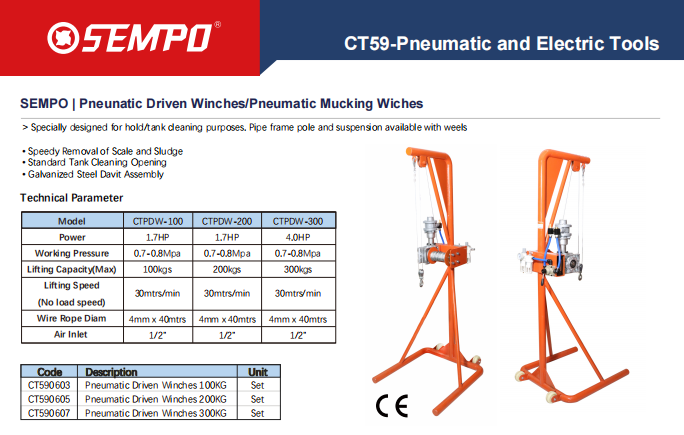Marine operations depend significantly on specialized equipment to ensure both safety and efficiency. Among these tools, Marine Pneumatic Driven Winches are particularly notable for their reliability and effectiveness in lifting and pulling heavy loads. To optimize their performance and extend their lifespan, it is crucial to implement proper maintenance practices. This article will discuss effective maintenance strategies for pneumatic driven winches, ensuring they remain in peak working condition for ship chandlers and marine supply operations.
Understanding Marine Pneumatic Driven Winches
Before addressing maintenance, it is essential to comprehend the function and operation of pneumatic driven winches. These winches utilize compressed air for operation, making them particularly suitable for marine settings where electrical equipment may present safety hazards. Models such as the CTPDW-100, CTPDW-200, and CTPDW-300 are engineered to accommodate various lifting capacities, ranging from 100 kg to 300 kg, thus providing versatility for different marine applications.
Key Features of Marine Pneumatic Driven Winches
- Working Pressure: Operates at a pressure range of 0.7-0.8 Mpa.
- Lift Speed: Capable of lifting at speeds of up to 30 meters per minute when not loaded.
- Durability: Made from galvanized steel to endure the harsh conditions of marine environments.
- Air Inlet: Generally equipped with a 1/2 inch air inlet for straightforward connection to a compressed air supply.
Importance of Regular Maintenance
Consistent maintenance of your marine pneumatic driven winch not only improves its performance but also extends its operational lifespan. Failing to conduct regular maintenance can result in diminished efficiency, heightened accident risks, and expensive repairs. Below is a detailed guide on how to effectively maintain your pneumatic driven winch.
1. Perform Routine Inspections
Visual Assessments
Begin with visual assessments of the winch and its various components. Check for indications of wear, corrosion, or damage, especially on the air hoses, fittings, and the winch drum. Any visible problems should be promptly addressed to avert further deterioration.
Operational Evaluations
Regularly evaluate the winch’s functionality through operational tests. Pay attention to any unusual noises during operation, such as grinding or squeaking, which may signal mechanical problems.
2. Ensure Proper Maintenance of the Compressed Air System
Quality of Air Supply
Verify that the compressed air supply is both dry and clean. The presence of moisture can cause corrosion and diminish the efficiency of the pneumatic motor. It may be beneficial to install air dryers and filters to uphold air quality.
Pressure Monitoring
Consistently monitor that the working pressure remains within the designated range of 0.7-0.8 Mpa. Fluctuations in pressure can adversely impact the winch’s performance and potentially lead to mechanical failures.
3. Lubrication Practices
Consistent Lubrication
Adequate lubrication is essential for the seamless operation of moving parts. Utilize high-quality lubricants that are appropriate for marine conditions. Pay particular attention to the following components:
Gearbox: Ensure the gearbox is sufficiently lubricated to minimize friction and wear.
Bearings: Regularly apply lubricant to bearings to ensure smooth functionality.
Wire Rope: Lubricate the wire rope to prevent rust and wear, maintaining its flexibility and strength.
Caution Against Over-Lubrication
While lubrication is vital, it is important to avoid excessive lubrication, as this can attract dirt and debris, leading to more significant complications.
4. Regularly Maintain the Winch
Debris Removal
It is essential to keep the winch free from salt, dirt, and other contaminants. Regularly clear any accumulation on the winch drum or around its moving components to prevent corrosion and mechanical failures.
Cleaning Agents
Utilize cleaning agents that are suitable for marine equipment. Steer clear of harsh chemicals that may harm the winch’s surface or internal parts.
5. Examine and Replace Worn Components
Wire Rope Assessment
Conduct regular inspections of the wire rope for any signs of fraying, kinking, or corrosion. If any damage is found, replace the wire rope to ensure safe lifting operations.
Component Replacement
Identify and replace any components that exhibit wear, such as seals, bearings, and air hoses, promptly to ensure optimal performance and safety.
6. Training and Operation
Operator Education
Ensure that all operators receive comprehensive training on the use and maintenance of the winch. They should be familiar with the operational limits and safety protocols associated with pneumatic-driven winches.
Safe Operating Procedures
Promote safe operating practices, such as refraining from overloading the winch and using it solely for its designated purpose. Proper usage minimizes wear and tear on the equipment.
7. Documentation and Record Keeping
Maintenance Records
Maintain thorough records of all maintenance activities, inspections, and repairs conducted on the winch. This documentation can assist in identifying recurring issues and inform future maintenance strategies.
Manufacturer Recommendations
Consult the manufacturer’s maintenance guidelines for specific recommendations pertaining to your model, including service intervals and replacement parts.
8. Seasonal Maintenance
Pre-Season Inspections
Prior to the commencement of the peak season, it is imperative to perform a comprehensive inspection and maintenance check. This process will confirm that the winch is fully functional and prepared for intensive use.
Post-Season Storage
When the winch is to be stored for a prolonged duration, it is crucial to clean it thoroughly, lubricate all moving components, and cover it to shield it from dust and moisture.
Conclusion
Proper maintenance of your Marine Pneumatic Driven Winch is vital for ensuring its dependability and efficiency in maritime operations. By adhering to these maintenance guidelines, ship chandlers and marine service providers can enhance the performance of their equipment, minimize downtime, and improve safety.
Allocating time and resources for regular maintenance not only prolongs the lifespan of your winch but also facilitates smoother and safer operations at sea. For further inquiries or to discover high-quality pneumatic driven winches, please reach out to reputable manufacturers such as Chutuo at sales@chutuomarine.com. Make maintenance a priority today to guarantee that your winch remains a valuable asset for many years to come.
Post time: Mar-14-2025







